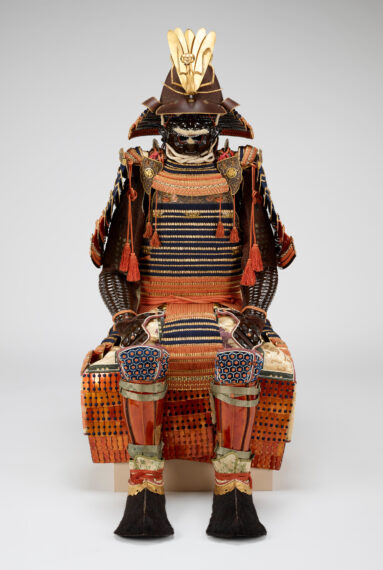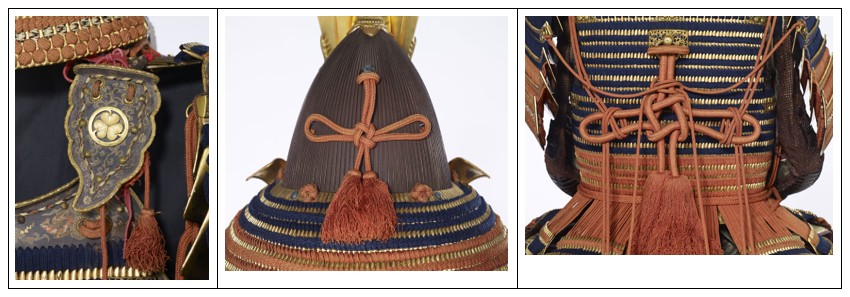
Japanese Samurai Armor
Lesson Objective
Students will learn about the meaning and function of this Japanese armor in Mia’s collection. Inspired by the context provided, let your students brainstorm about how they would design their suit of armor using material and symbols that hold a deeper meaning to them.
Introduction
Precious materials, fine details, and exceptional craftsmanship—all are hallmarks of the beauty and artistry in Japanese culture. A clever design made this lightweight suit of armor highly protective when worn by a Japanese samurai warrior in hand-to-hand combat.
The armor’s ownership can be traced to the Kii branch of the Tokugawa family, who ruled Japan for nearly 250 years. It may have been made for Tokugawa Yorinobu, the founder of the branch.

Red-and-blue-laced Suit of Armor from the Kii Tokugawa Family, mid-17th century. Japan (suit); Saotome Iechika (helmet), Japanese. Edo period (1603–1868). Iron, leather, lacquer, silk, wood, gold leaf and powder, bear fur. The Ethel Morrison Van Derlip Fund. 2009.60a-s
Warm-Up Questions
- • Take a moment to look at the armor. What do you notice? What more can you find?
- • Creatures appear throughout the armor. The Chinese Four Guardians—the Azure Dragon, Vermilion Bird, White Tiger, and Black Tortoise—provided protection to the wearer. The praying mantis on the helmet suggested what the wearer of this armor would do to his enemies: cut them down.
- • How might it feel wearing a suit of armor? Why?
- • If you were designing a suit of armor, what materials would you use? Why? How would it look? Start with the helmet and work your way down to the boots.
Background
Serving in Style

Kobayashi Kiyochika, Japanese, 1847–1915. Warrior Departing for a Battle, c. 1880–99. Woodblock print; ink and color on paper. Bequest of Louis W. Hill, Jr. 96.146.331
From the 14th to the 19th centuries, Japan was ruled by a feudal government system. Regional families known as daimyo (“dime-yo”) controlled vast territories of land and workers. Frequently at war with one another, daimyo employed highly skilled warriors, known as samurai, to protect their riches. Samurai were highly regarded in Japanese culture for their loyalty and dedication, as well as their prominent social status.
Samurai get their name from the Japanese word saburau, meaning “to serve.” These warriors were famous for their bravery, loyalty, and commitment to duty. They were also known for their distinctive armor. This suit of armor includes a helmet topped with a praying mantis. Known for its fearlessness, this insect would have symbolized the wearer’s bravery on the battlefield and embodied his threat to the enemy.
Over the centuries, samurai gained elevated status within feudal Japan’s tiered society. Most were wealthy and educated, and their interests in and patronage of art forms such as architecture, calligraphy, poetry, and the unique Japanese tea ceremony helped to develop, enhance, and define Japan’s artistic culture. Objects like this suit of armor emphasize the importance of beauty and artistry of even the most functional objects, values that continue to be important in Japanese society today.
It’s All in the Suit

Left: The presence of the hollyhock, the crest or coat of arms of the Tokugawa family, may indicate the importance of its owner. Center: This acorn-shaped helmet was made with an impressive 124 plates of metal. Right: Red dye, made from safflower, was an expensive luxury and emphasizes the status of the armor’s owner.
In 1600, the Tokugawa family took control of Japan. Their rule brought 250 years of peace and stability to the country, an era known today as the Tokugawa, or Edo, period. This suit of armor was made early in this reign in the Kii Province, which was headed by Tokugawa Yorinobu (1602–71), the 10th son of the dynasty’s founder. Although the identity of the armor’s original owner is uncertain, it is possible that the suit was made for Yorinobu himself; a hollyhock, the crest of the Tokugawa family, can be found in multiple locations on the armor.
Even during the peaceful Edo period, soldiers practiced military skillfulness and produced protective armor. However, craftsmen placed greater attention on appearance and combined the most striking features of older styles into stunning new suits of armor.
From top to bottom, this suit of armor features outstanding embellishments that indicate the status of its owner. An impressive number of crimped metal layers make up the helmet, or kabuto, which is topped by a delicately carved and gilded praying mantis.
Gold is also lacquered onto the hundreds of metal plates, or sane, which form the suit’s protective coverings. Delicately painted scenes on protective leather back-and-chest plates illustrate animals traditionally associated with luck and longevity.
Some of the expensively dyed silk cords fasten the sane together, while elegantly knotted others hold the protective layers in place.
Fully Functional

Left: Half armor, c. 1570–80. Italy. Steel, leather, cloth. Gift of Wayne and Rosalee MacFarlane. 2001.111a-j. Center: Hundreds of metal plates, lacquered and gilded, are laced together with red and blue silk cords to produce a flexible shield capable of protecting the warrior from an enemy’s sword. Right: Hand and arm guards add to the full-body protection of the samurai.
Though this stunningly decorated suit of armor was unlikely to have been worn in battle based on its near-perfect condition, it was made to be practical and battle ready. Its components are fitted, lightweight, and very flexible, allowing for freedom of movement as a samurai fought with his sword. Even the helmet’s fanciful praying mantis would have torn away easily in battle so as to not entangle the warrior with his enemy.
A distinguishing feature of Japanese armor are the hundreds of tiny iron and leather sane plates stacked together and covered in lacquer and gold leaf, then laced together with silk cords. Sane panels flexed and moved with the warrior, protecting him from the sword of his enemy.
The skirt, or kusazuri, was also made up of sane to protect the lower body. It’s divided into eight sections to allow the wearer ease of mobility.
Fancifully knotted silk cords are not only beautiful, but they also function to keep the plated shoulder guards in place while enhancing freedom of movement.
Further shielding its wearer, this suit of armor includes additional features such as a facemask, helmet, throat protector, hand and arm guards, leg guards, and boots. Unlike rigid Western armor, this Japanese suit is light and flexible and allowed the wearer a greater range of motion in battle.
Art Activity
The art activity provides two options depending on accessibility of materials and time.
Option 1: Have your students design a suit of armor inspired by the information provided, but unique to each student’s interests and inspiration.
Option 2: If time permits and materials are easily accessed, have students create a wearable work of art that honors someone special in their life now or from their past. Use whatever materials you have available. This could be armor or a helmet.
Materials
Option 1:
- • Markers, crayons, colored pencils, etc.
- • Paper
Option 2:
- • Recyclables
- • Construction paper
- • Scissors
- • Glue
- • Tape
Guided Practice
Take a moment to think about the people in your life that are important to you. Who is important to you? What do you admire about them? How do they inspire you? What symbols or objects do you associate with them?
List out any detail that will assist in the creation of your drawn suit of armor or your wearable work of art.
Instructions
- 1. Option 1 and 2: Plan out the design of a suit of armor influenced by the information provided, implementing your interests and inspiration. Write it down or draw if you aren’t creating a wearable work of art.
- 2. Option 2: Based on your plans in the previous step, create your wearable work of art.
- 3. Option 2: Put on your suit of armor and show off the admiration you have for this person.
Reflection
How did this project make you feel? Reflect on what inspired you. What surprised you? What questions do you still have?
How might learning about warriors and their armor teach us about their culture? Why do you think this is important to learn about? What was your favorite part? Why?
Optional Learning Extensions
Worldly Warriors
Use the search function on Mia’s website to search for other artworks related to warriors, arms, and armor from around the world. Compare what you see.
What does European armor have in common with the Japanese suit of armor? What differences do you notice? Which seem to be the most comfortable, flexible, and functional? What do you see that makes you say that?
Minnesota State Standards
Visual Arts
5.0.4.7.1 – 5.9.4.7.1 Respond: Analyze and construct interpretations of artistic work.
5.0.5.9.1-5.5.5.9.1 Connect: Integrate knowledge and personal experiences while responding to, creating, and presenting artistic work.
